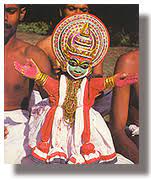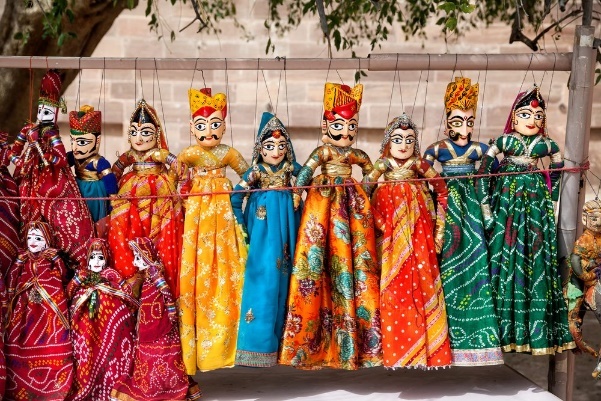The fascinating world of Indian puppets…. By Mrs. Shomita Nair ( Grade 2 Teacher)
The fascinating world of Indian puppets…. By Mrs. Shomita Nair
“हम सब रंगमंच की कटपुतलिया है जिनकी डोर उपरवाले की उँगलियों से बंधी हुई है”. Most of us who remember the movie Anand will remember this dialogue by superstar Rajesh Khanna where he talks about us humans as puppets who are controlled by the divine creator. That is on a philosophical note but the role of puppetry in Waldorf education is just as profound.
Story telling through puppets in the Waldorf curriculum
Puppetry or a puppet play exudes simplicity and calmness in the way a story is narrated and built upon. When a child watches a puppet show, it stimulates their fantasy, strengthens their life forces and as it unfolds step-by-step it evokes their imagination and they move forward with the story. It is more relevant in today’s fast-paced world because when the stories are acted out in front of children it also has a calming effect on them.
It is said that when Rudolf Steiner was asked how to do puppet plays, he insisted that the marionettes must hang on threads tied directly to the fingers (not a cross bar), directed from above. He had clear views on how the story must be read, style and colour of the costume fabric and stage lighting and scenery. Puppetry is an integral part of the Waldorf curriculum as the sole purpose of puppet plays is, according to Steiner, to help the children to develop fantasy.
India: the birth place of puppetry
The world of puppets is a very colorful world just like the colouful milieu of the Indian subcontinent. So it is hardly surprising that this form of art originated here. Early references of puppetry in India can be found in the Tamil classic ‘Silappadikaaram’ written around 1st or 2nd century BC. The content of the puppet shows in the Waldorf curriculum is similar to that of traditional puppet theatre in India which is mainly stories of the legends, puranic stories and local myths.
There are 4 major different types of puppets used in India. Glove Puppets, Rod Puppets, Shadow Puppets and String Puppets.
Glove Puppets

Glove Puppetry is popular in many parts of India. It’s sheer pleasure to see this art form unfold in the hands of a master puppeteer. In Glove Puppetry, the heads and arms of the puppets are controlled by the fingers of the puppeteer and it can produce a wide range of movements.
Found in Orissa, Uttar Pradesh, Kerala, and West Bengal, the themes and the delivery of the story varies from place to place. In Uttar Pradesh, stories are often based on social themes while in Odisha the stories narrate the tales of Radha and Krishna. Pavakoothu, a glove puppetry form from Kerala, draws inspiration from Kathakali depicts the fables of Ramayana and Mahabharata.
Rod Puppets

It is an extension of glove puppetry but on a much larger scale. Mostly found in West Bengal and Odisha, the puppets in this form are manipulated using rods.
It is believed that the Rods Puppets have better control compared to other forms. The Putul Nautch from the Nadia district of West Bengal are about 3-4 feet in height. One gets a highly theatrical experience while watching this form of puppetry. During the show, a group of musicians play the music and the main dialogue and songs are delivered by the puppeteer.
Shadow Puppets

Shadow puppets are flat and operated against a white clothed screen. It is highly technical in nature and it is all about judging the perfect balance between the light and the screen. The correct manipulation of both will result in a project of a gorgeous silhouette and colorful shadows. In India, this form is very popular and has varied styles depending on the geographical location.
The Shadow Puppet shows begin at night and continue till dawn. Puppet sizes reflect the social status of the character that they play. Larger puppets are for royal and religious members while smaller puppets depict the common people and servants. Known as Tongalu Gombeyaata, the puppets are mostly colored in red, blue, black or green. While conventionally the form was used to portray stories of the Ramayana and Mahabharata.
String Puppets

It is one of the most popular forms of puppetry in India. The Kathputli that is referred to in the aforementioned movie dialogue falls in this category. Also, these puppets are the ones recommended by Steiner for storytelling in the Waldorf curriculum. String puppets have jointed limbs, controlled by strings that allow flexibility. This makes them the most articulate of all the puppets and also the most challenging. It takes years of practice to control these puppets. It is mostly popular in in Rajasthan, Odisha, Andhra Pradesh, and Tamil Nadu.
Kathputli- Rajasthan’s form of string puppetry involves large colorful dolls that are vibrantly dressed. Puppeteers speak in shrill voices produced when spoken through a bamboo reed. The subjects presented are mostly social problems like dowry, women’s empowerment, illiteracy, and poverty.
An art form that has stood the test of time
As an art form that has lived and evolved centuries, puppetry is enriching not just for the children but also for the puppeteers. Just like the children who watch it with awe every time and exercise their faculties of imagination, the performers too get in touch with their own sense of creativity with each performance and evolve along the way.

 Previous Post
Previous Post Next Post
Next Post